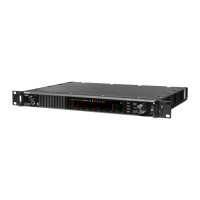
Do you have a question about the Shure AD600 and is the answer not in the manual?
| Brand | Shure |
|---|---|
| Model | AD600 |
| Category | Controller |
| Language | English |
Highlights the advanced features and capabilities of the AD600 Spectrum Manager.
Lists all the components included with the AD600 Spectrum Manager.
Provides guidance on how to properly mount the AD600 in an audio rack.
Describes the headphone volume control and 1/4" audio output jack.
Details the color display and programmable function buttons for navigation.
Covers ENTER, EXIT buttons, control wheel, and power switch functions.
Explains AC power input, cascade, Ethernet ports, and network status LEDs.
Details USB port, antenna bias LEDs, coaxial inputs, and cooling vents.
Explains the home screen display, RF activity, and the meaning of various icons.
Describes how to use function buttons, control wheel, ENTER, and EXIT for navigation.
Illustrates a system setup where all devices operate within the same frequency range.
Demonstrates a system configuration supporting receivers in different frequency ranges.
Details the 6 antenna ports and how to manage bias power for active antennas.
Guides users on configuring antenna parameters like range and bias for optimal performance.
Shows how to configure antennas for wideband coverage across multiple frequency bands.
Illustrates antenna placement for providing RF coverage in large venues and minimizing dead spots.
Explains antenna spacing for linear coverage in areas like hallways or runways.
Describes supported network signal types: Shure control and Dante primary/secondary.
Outlines the guided setup process for simplifying network configuration of the gear.
Explains how networking modes determine signal routing to ports for flexible network setup.
Step-by-step guide to setting the network switch mode to Switched or Split Redundant.
Details automatic IP address assignment using DHCP for network communication.
Explains manual IP address assignment for network components.
Describes using the Network Browser to view connected Shure devices and their status.
Guides users through the process of creating or modifying frequency coordination settings.
Details manual parameter settings for advanced frequency coordination needs.
Covers tools like Cursor, Zoom, Range, Capture, Open scan, Live scan, Listen, Save snapshot, and Markers.
Explains how to monitor demodulated audio from wireless devices via the headphone jack.
Guides on listening to audio from Dante-enabled devices on the network.
Describes how the Frequency List Monitor displays device and frequency status.
Details capturing RF activity and saving scan data files for analysis or coordination.
Explains how to load previously saved scan files and snapshots.
How to set the internal clock for time-stamping scan files and event logs.
Prevents accidental or unauthorized changes to controls and settings via panel locks.
Adjusting headphone volume and limiter threshold for audio monitoring.
Customizing display brightness and sleep time settings.
Configuring fan speed for optimal cooling based on temperature.
Provides common troubleshooting steps for network and device issues.
Describes how to view, export, or clear the event log for troubleshooting.
Information on updating the device's embedded software for new features and enhancements.
Steps to restore all device parameters to their original factory settings.
Definitions for Access control, Backup frequency, Compatible frequency, and Compatibility level settings.
Covers RF tuning, noise floor, dimensions, weight, housing, and power requirements.
Details current drain, temperature, RF input, audio output, networking interface, and Dante support.
Covers network addressing capability and DC module input voltage, current, protection, and connector.
Provides FCC compliance information and advice on correcting radio/TV interference.
Regulatory warning for wireless operation in Australia.
Regulatory warning for wireless operation in Canada.
States compliance with Canadian ICES-003 and licence-exempt RSS standards.